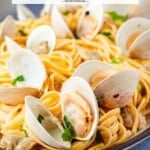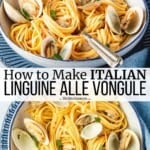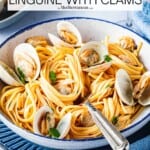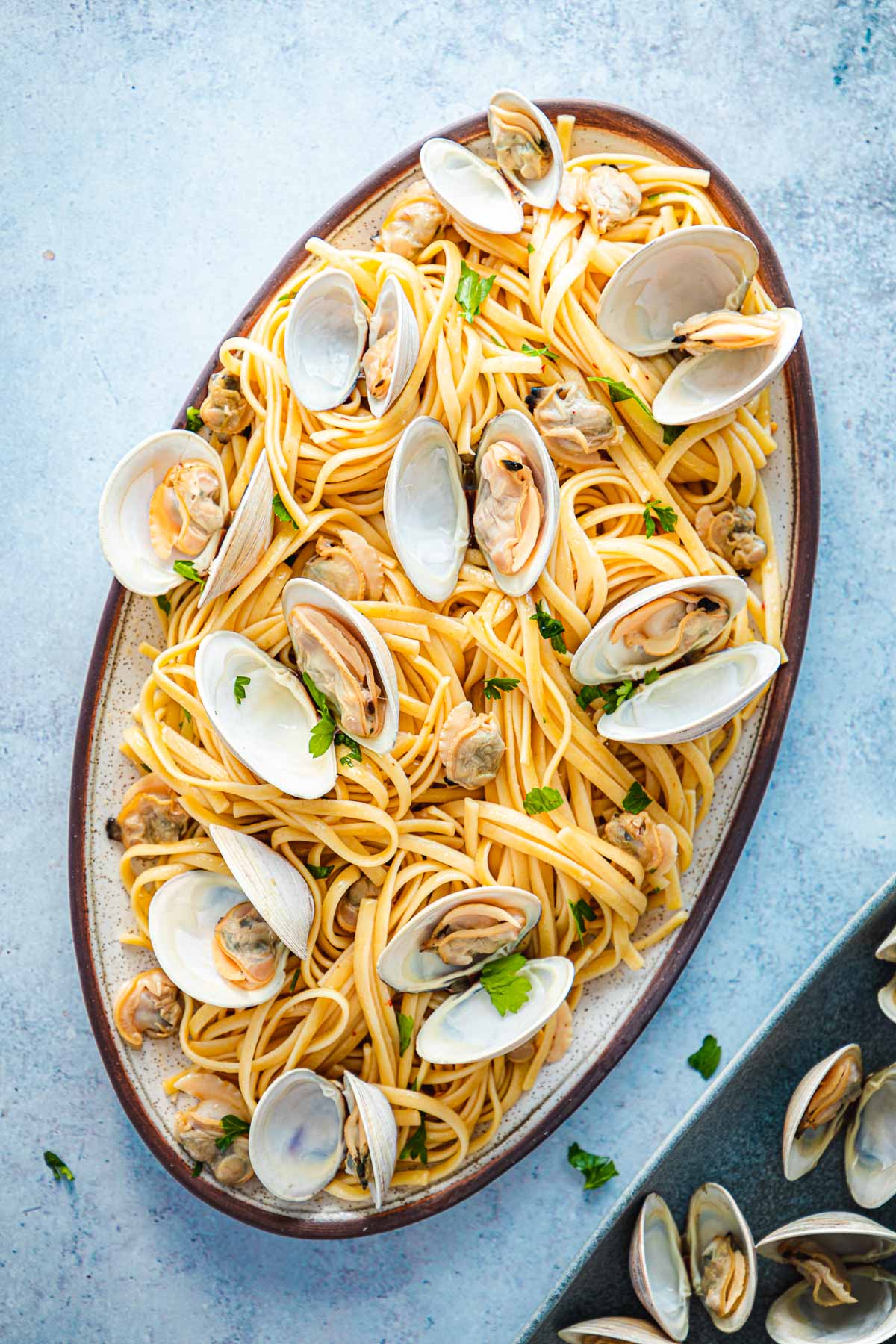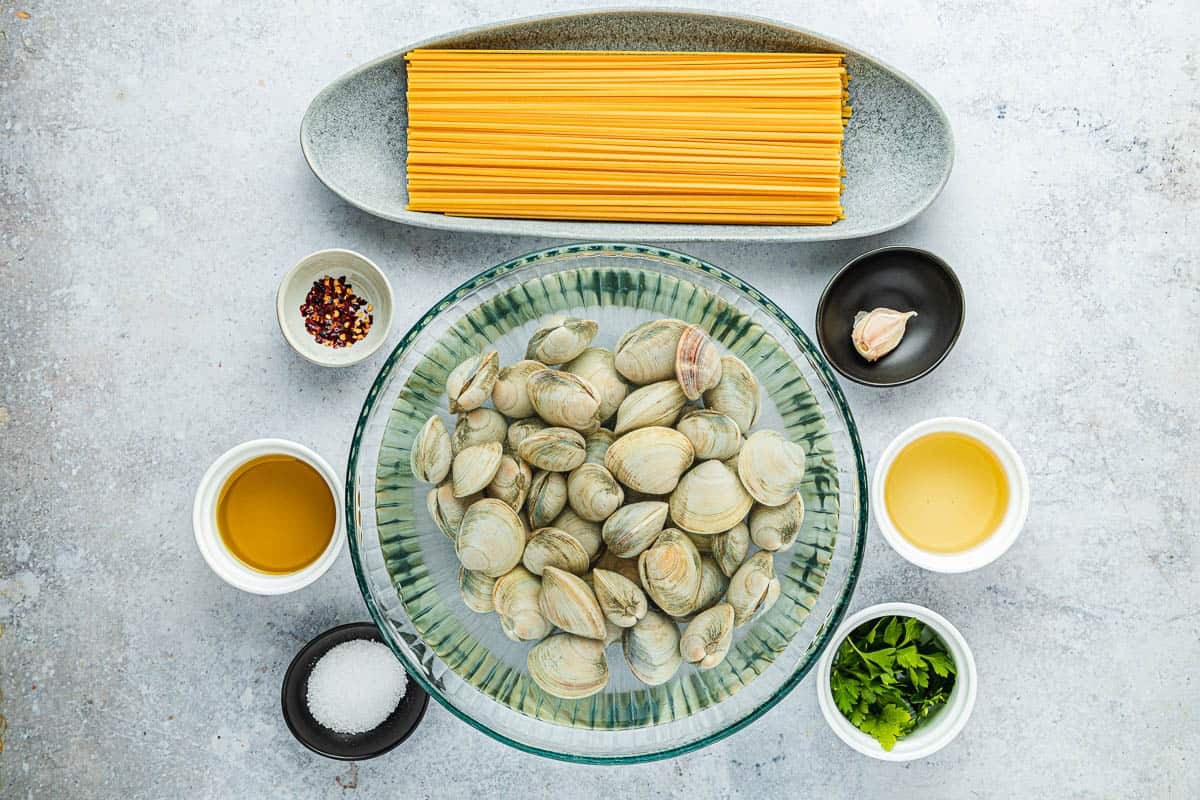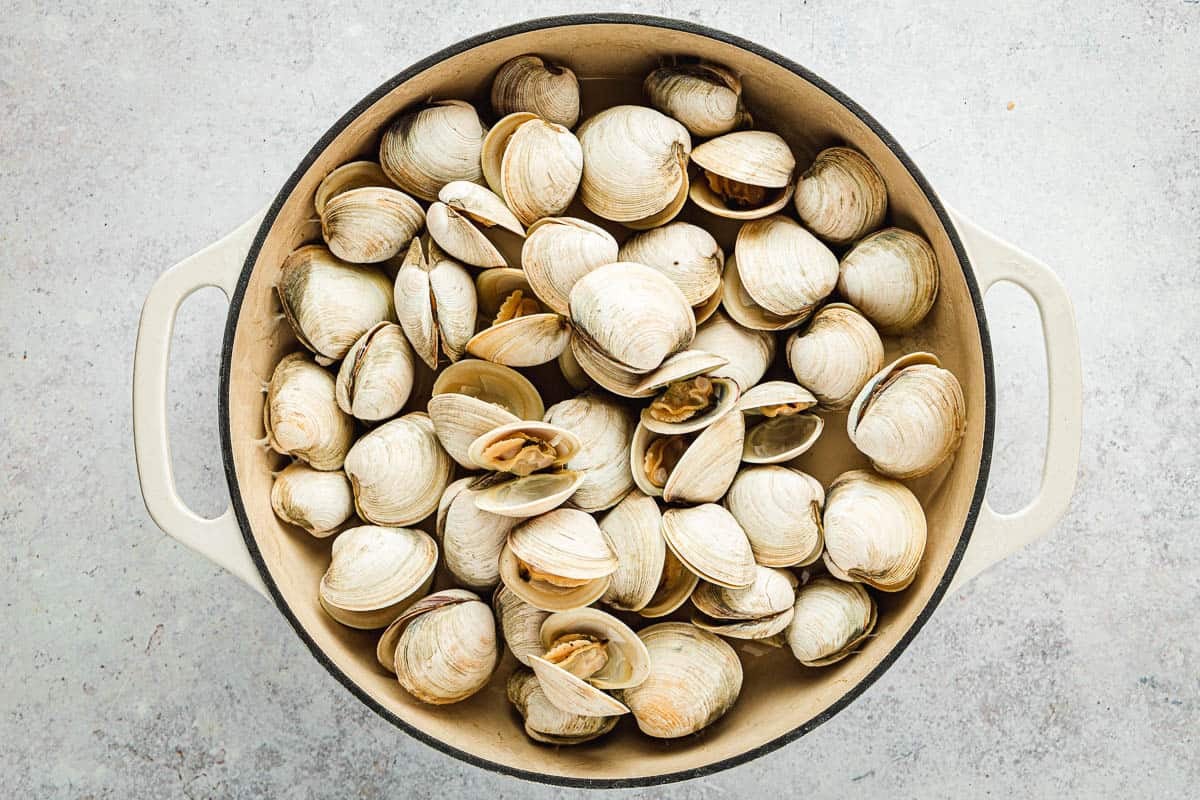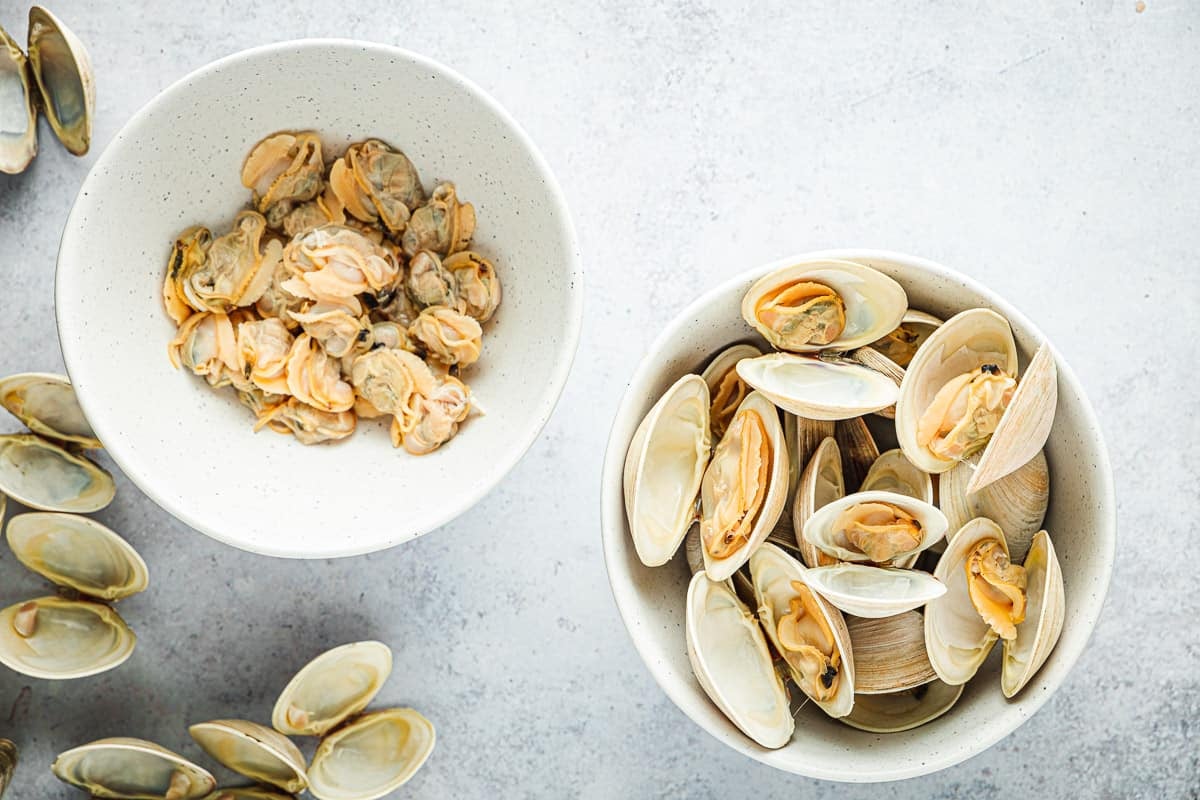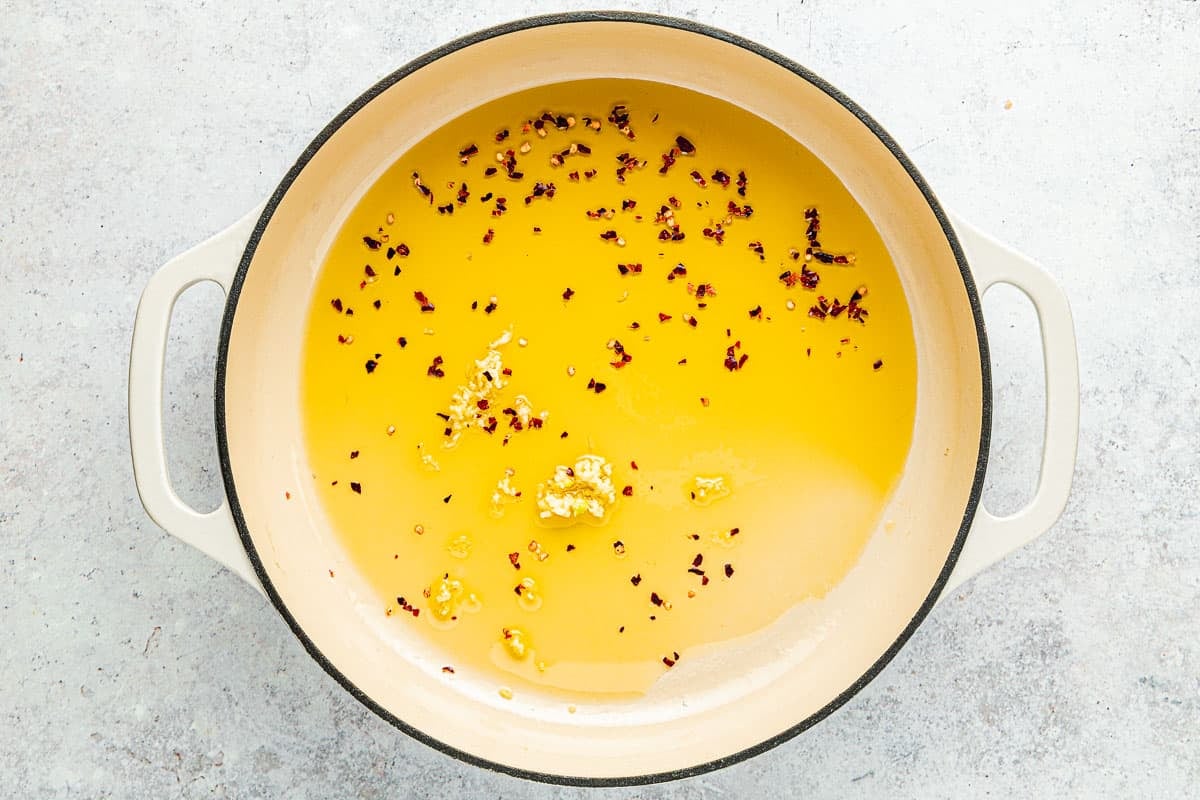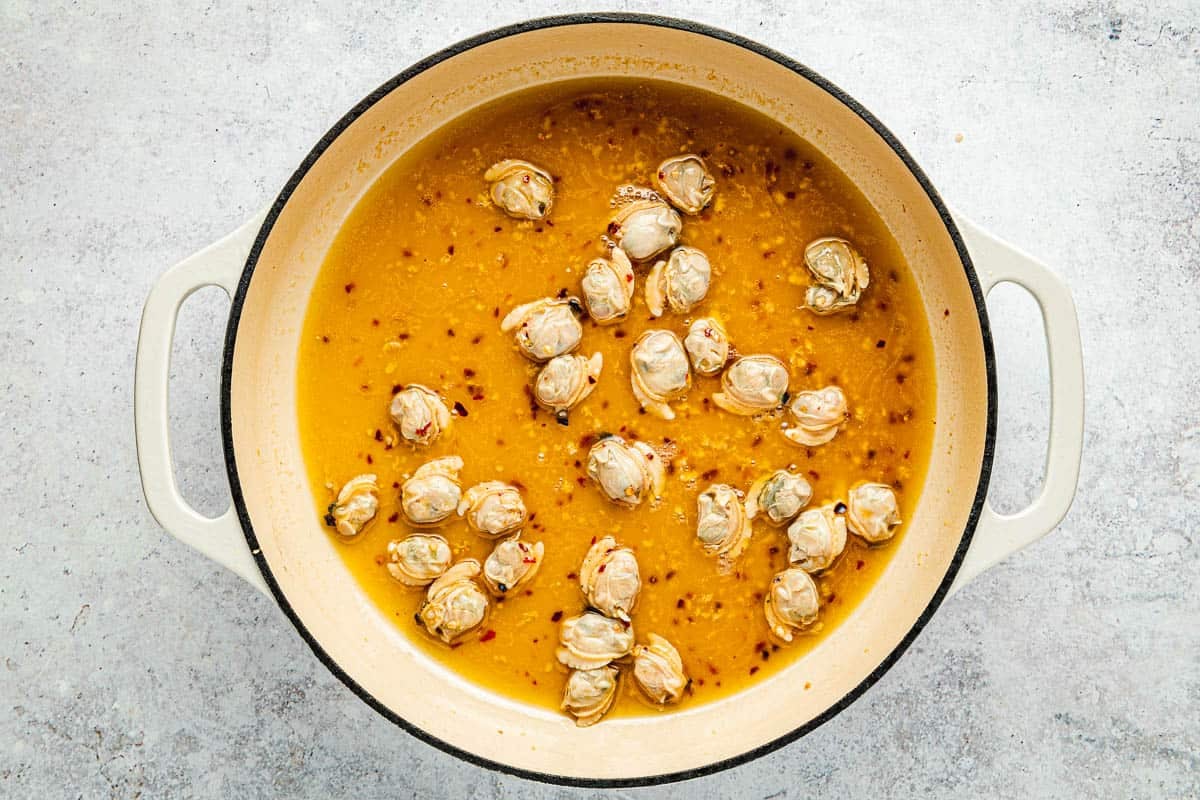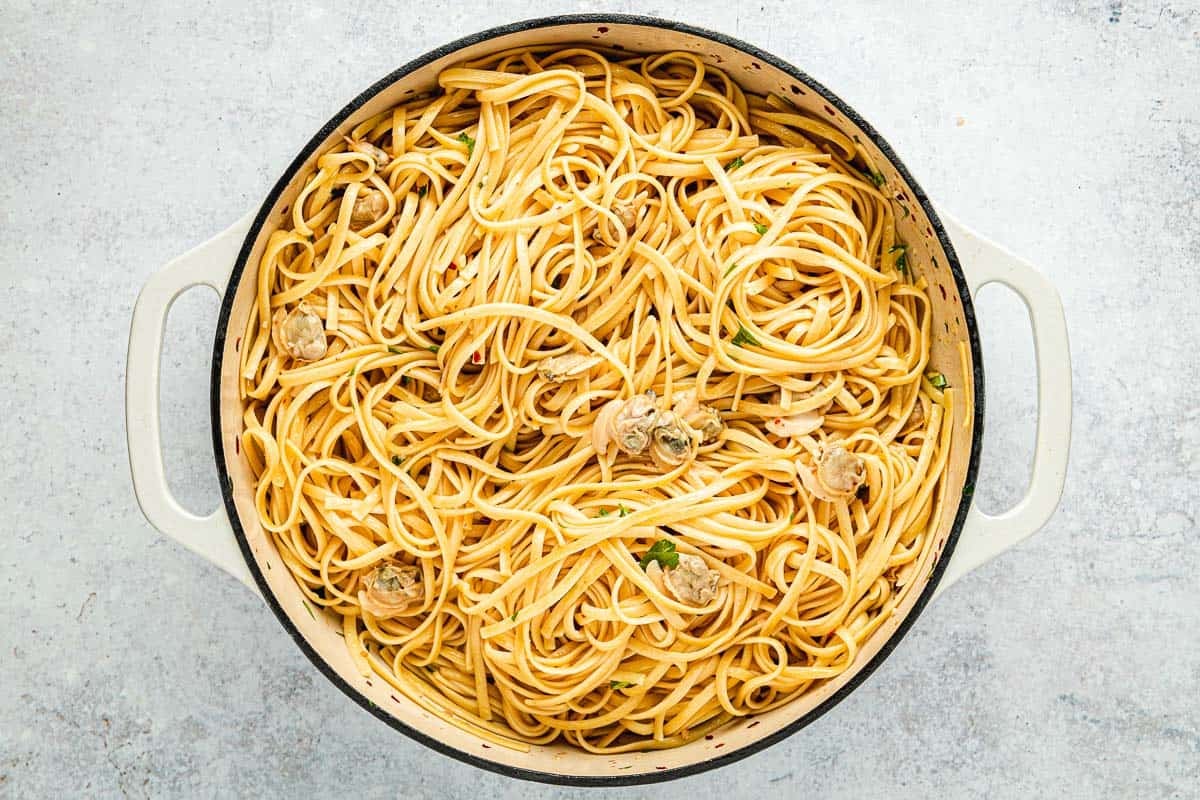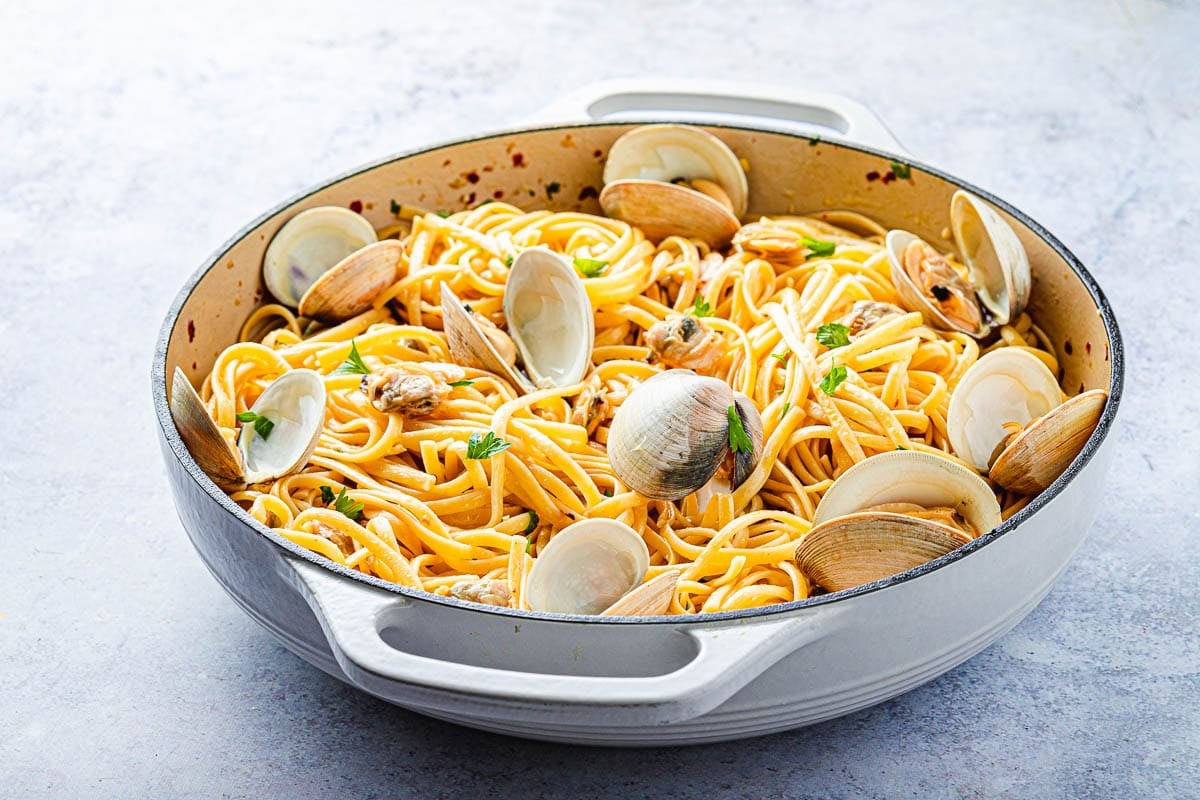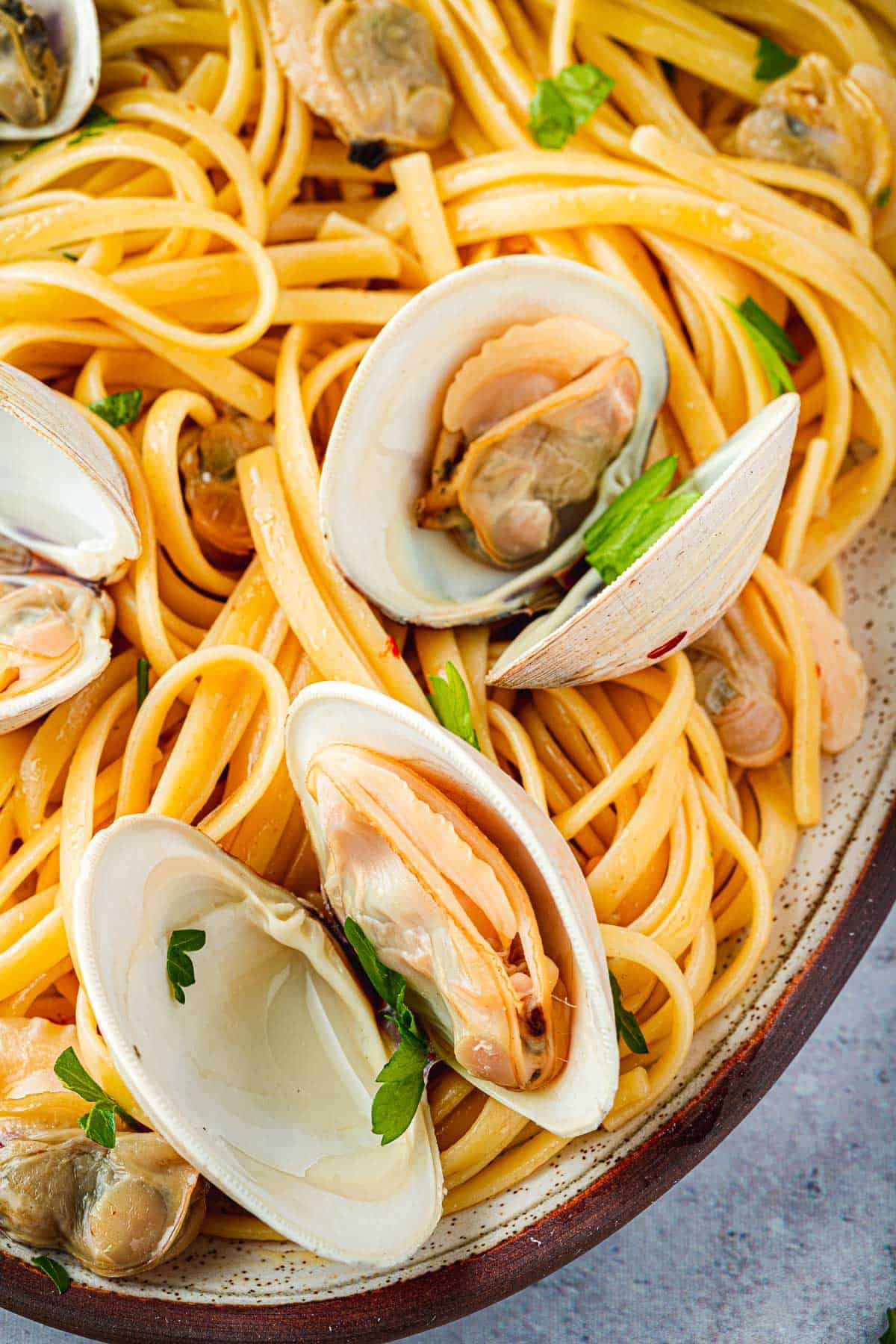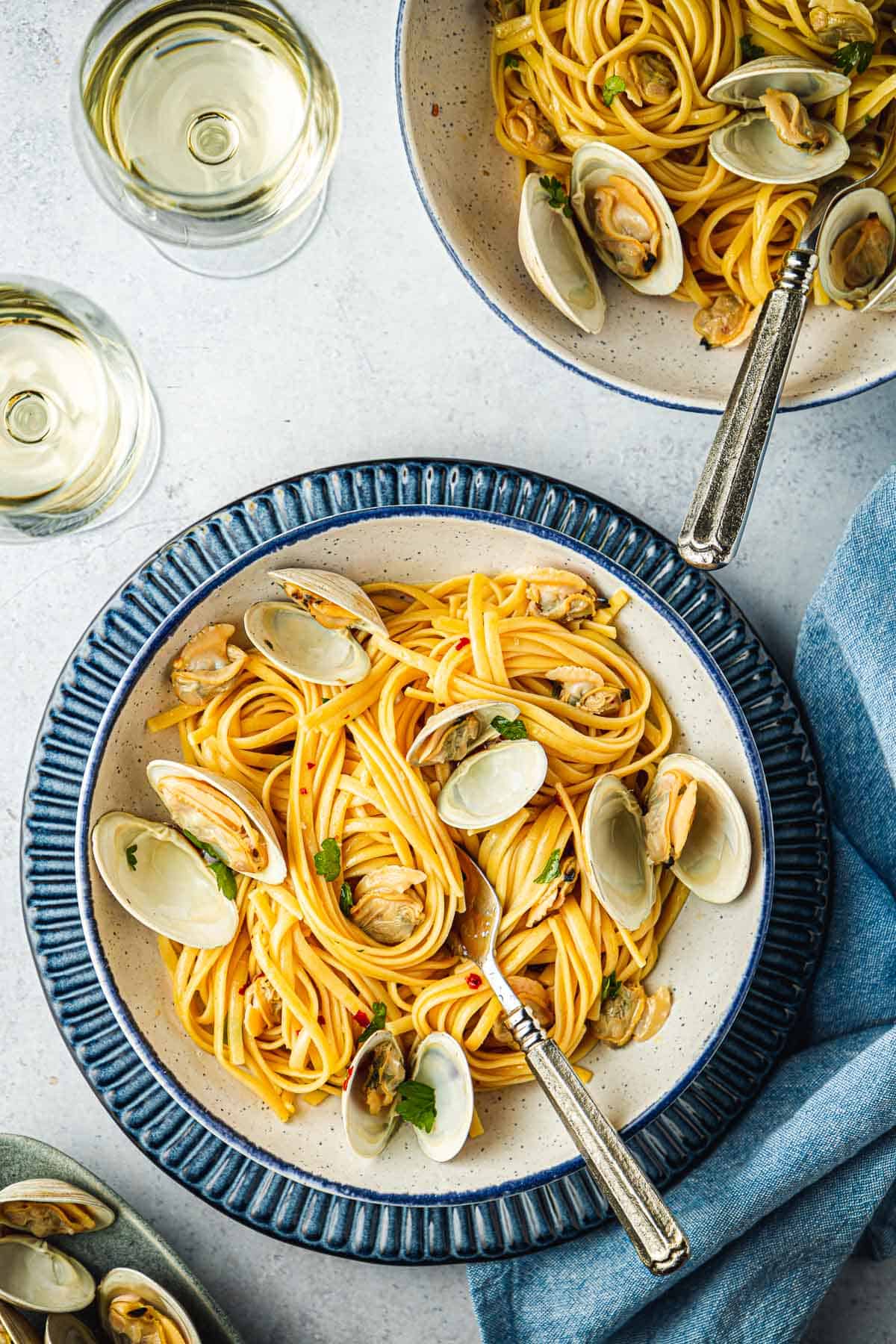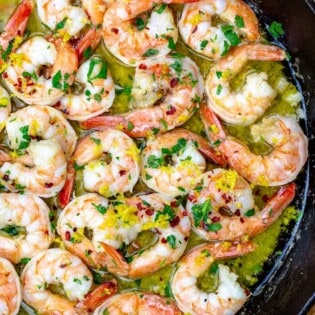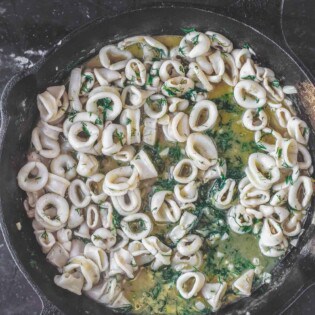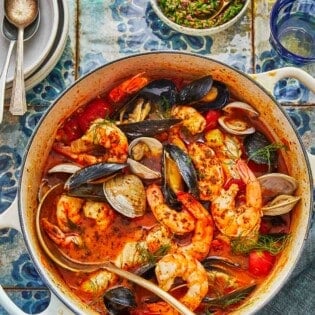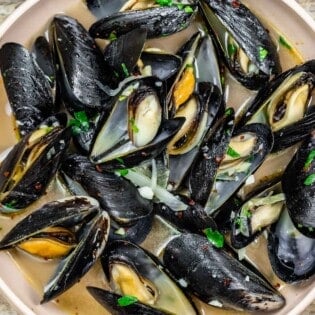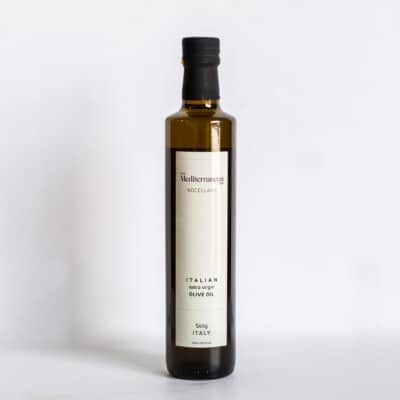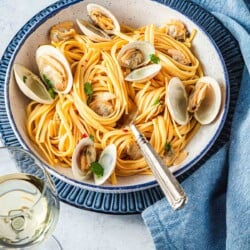Linguine with Clams is is an Italian pasta that I probably crave more than any other (if I absolutely had to pick just one)! Serve it with a Lemon Parmesan Lettuce Salad, crispy, pillow piece of freshly baked focaccia and a crisp white wine.
What is Linguine alle Vongole?
Linguine alle Vongole is a classic Italian seafood dish popular all over the country, which isn’t surprising given that the whole region is a peninsula brimming with the freshest seafood. Whenever I’m at a restaurant on the coast of Abruzzo, where my family is from, I almost always order it. Linguine alle Vongole is a special treat when I’m near the Adriatic Sea, but I also love to make it at home. It’s one of the easiest dishes in Italian cuisine, as long as you follow one simple rule: Less is more. That means no cream, no onion, no lemon, and no cheese! That’s right: This mouthwatering pasta recipe also happens to be dairy free. Fresh clams are cooked in a white wine and garlic sauce until they open, releasing their flavorful juices and creating a delicious broth that coats the spaghetti. It’s what’s known as an al minuto sauce, meaning it comes together in just a few minutes. You only need six ingredients, in addition to the pasta, to make authentic Linguine alle Vongole: Olive oil, garlic, red pepper flakes, parsley, fresh clams, and white wine. It goes without saying that these ingredients should be top notch, especially the clams, which should be alive and still in the shell—no canned clams! If you’re reluctant to cook with fresh clams, don’t be. Most clams sold in the U.S. are sustainably farmed and easy to clean and cook. You won’t believe what a difference fresh clams make in Linguine alle Vongole.
Linguine alle Vongole Ingredients
With just a few ingredients, mostly from the pantry, you can have linguine with clams on the table in under an hour. Here’s what you need to make Linguine alle Vongole:
Fresh clams: You’ll need about 4 dozen small live clams still in the shell, such as Manila, littleneck, or cockles. Littlenecks are the most widely available, and they have an appealing meaty texture. Manilas and cockles are smaller and more delicate, but with big flavor. Any of these will be delicious! Olive oil: Use good-quality extra-virgin olive oil that tastes fresh and vibrant, like our Nocellara Italian EVOO. Garlic: You only need one large or two small cloves of garlic. It shouldn’t be the dominant flavor; it should play a supporting part to the clams’ starring role. Red pepper flakes: A generous pinch, about 1/2 teaspoon, to shake things up a bit. Dry white wine: Cooking wine doesn’t have to be expensive, but it should be something you would actually drink. Linguine: A one-pound package serves 4 people. The flat noodles make the sauce seem even silkier. Spaghetti also works great in this dish; go with your preference. Parsley: A shower of fresh flat-leaf parsley adds a bright, fresh note and a splash of color to the dish.
How to Make Linguine alle Vongole
Linguine and clams comes together with just a few steps and tastes restaurant-worthy. The first step is the most important: soaking the clams in salted water will “purge” them to remove sand and grit. No one wants a bowl of gritty linguine alle vongole!
Purge the clams: Scrub the clams under cold running water or in a bowl of cold water. Use a stiff brush to remove grit from the outer shells. Pile the clams into a large bowl and cover them with cold water. Pour in enough coarse salt to make a salty solution—a good handful. Let the clams sit for 15-30 minutes, giving them a gentle stir now and then. Drain them and rinse them well to remove any additional debris. Don’t worry if there is still a little grit; you’ll be filtering the clam juice after steaming open the clams. Steam the clams: Put the clams into a deep skillet or a large sauté pan. Add 2 tablespoons of water, cover, and set over medium-high heat. The clams will start to open within a couple of minutes. To avoid overcooking, open the lid from time to time and use tongs to transfer any open clams. Shake the pan from time to time to distribute them and cook until all of the clams have opened, 5-8 minutes. Discard any unopened clams that remain. Separate the clams: Set aside a handful of clams in their shells –3 or 4 per serving—to use as a garnish. Once the remaining opened clams are cool enough to handle, use a small knife or spoon to remove the meat from the shells. Place the meat in a small bowl. You will add it to the pasta later. Filter the clam juice: There will be some clam juice left in the pan from the steaming process. Don’t toss it! This is the most important part of the clam sauce. Line a fine-mesh sieve with a damp paper towel (make sure it’s damp or the paper towel will absorb the delicious clam juice). Set the sieve over a mixing bowl or and pour the clam juice through it. Reserve the liquid. Get the pasta water going: Bring a large pot of water to a boil over medium-high heat. Sprinkle in a little salt, but not as much as usual since clam juice is salty. Cook the garlic: While the pasta water is coming to a boil, set a skillet large enough to hold the cooked spaghetti over medium-low heat. Add the olive oil, minced garlic, and red pepper flakes. Cook, stirring, until the garlic is softened and fragrant, about 5 minutes. Add the wine and clam juice: Pour in the wine and raise the heat to medium-high. Let the wine simmer for one minute, then add the reserved clam juice and the shucked clams. Cook just until the clams are heated through and everything is well combined, about 1 minute. Turn off the heat and cover to keep warm while you cook the pasta. Cook the spaghetti: Drop the spaghetti into the boiling water and stir to separate the noodles as they soften. Cook until the noodles are al dente—a minute or two less than the recommended cooking time on the package. Add the pasta to the sauce: When the spaghetti is still al dente, turn the heat back on under the clam sauce. Use tongs to transfer the noodles to the skillet and let them finish cooking in the sauce, 1-2 minutes. Be sure to toss the noodles with the sauce to coat them well. Finish and serve: When the pasta is cooked to your taste, stir in the parsley and toss everything together one last time. Pile the spaghetti into a warmed serving bowl or deep platter (or four individual shallow bowls) and garnish with the reserved clams in the shell. Serve right away.
Best Clams for this Linguine and Clams Recipe
There are several varieties of clams you can use for this dish. Opt for small clams, as they are the most tender and also tend to have the most flavor (cherrystones are too big). My three favorite clams for spaghetti alle vongole are:
Littlenecks Manila Cockles
All are tender and flavorful. Littlenecks are the most widely available. They’re a little bigger than Manilas or cockles, but still tender and juicy.
How to Select and Buy the Freshest Clams
Most clams sold at fish markets and supermarket seafood counters are farmed, which means they have less grit than wild clams. Farmed clams are a great option for making spaghetti with clams at home because they’re generally more affordable, raised in clean water, and have a pleasant mild flavor. Here’s what to look for when buying fresh clams:
Live clams should be kept on ice: They’ll either be loose or in mesh bags nestled in the ice. If in bags, be sure to check the tag, which will tell you the date of harvest, where the clams are from, and the “use by” date. If the clams are loose or you don’t see a tag, ask the fishmonger. Getting your clams home: Don’t transport clams in a tightly closed bag or container. It might sound counterintuitive since they dwell in the ocean, but clams need oxygen. Transport in a bag with ice and keep the top of the bag open to allow the clams to breathe. Check each clam: Hard clams, such as littlenecks, Manilas, and cockles, should be tightly closed when you buy them. Sort through them to ensure clams are intact and without chipped or cracked shells. (The fishmonger can help you with this.) Inspect the clams when you get home. If you see any open ones, tap them lightly against the countertop. They should close up quickly. If they stay open, throw them out, as they are dead. Clams should smell fresh and briny, like the ocean. A strong fishy odor indicates they are past their prime.
How to Store Fresh Clams
Buy fresh clams the day you plan to cook them. They will stay fresh for 24-48 hours after you buy them, but I always prefer to cook them the same day. For short-term storage, place the clams in a large bowl and scatter a handful of ice cubes on them. Cover them with damp paper towels to retain moisture and put them in the refrigerator until you are ready to prepare them.
What to Serve with Linguine alle Vongole
This pasta is definitely company-worthy, especially for a casual dinner party, where everyone can have fun digging in and twirling their spaghetti. Start things off with a salad course, like this refreshing radicchio salad to wake up your palate. A dish of Linguine alle Vongole would not be complete without an accompanying glass of vino. My favorite wine pairing for this dish is Falanghina, a lively dry white with citrusy notes, from the region of Campania, in southern Italy. The wine’s minerality really complements the briny clam sauce. For dessert, serve Pizzicati (Italian Pinch Cookies), Cannoli, or Biscotti, perhaps with a digestif or a strong Italian espresso.
More Amazing Seafood Recipes
Browse all Mediterranean recipes.
Easy Shrimp Scampi Recipe
Easy Calamari Recipe with Garlic-Lime Sauce
Cioppino Recipe (Seafood Stew)
Steamed Mussels in Garlic White Wine Broth
Visit Our Shop Try our Nocellara Extra Virgin Olive Oil from 100% Sicilian olives.
